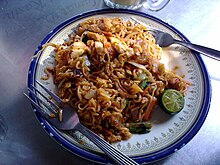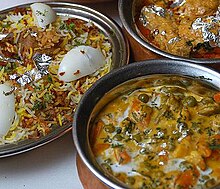Cuisine culture
Banana leaf
As nearly 90 percent of Malaysian Indians originated from South India, banana leaf is used traditionally to eat food from. The banana leaf meal is famous in Malaysia.[1] With rice at the center and different accompaniments like pickle, fried meat or vegetable, papadam (Indian fries made of lentils), it's a feast by itself and various curries that are served around this is not just a treat for the eyes but also to the palate.[2] Etiquette is important when it comes to a banana leaf rice meal. One part involves the practice of serving, namely the way the leaf is placed before a diner and where the food is placed on the leaf itself. Eating with one's hands is a must.
The folding aspect of the banana leaf is also contentious with many believing it to be a rating system – fold towards one to indicate satisfaction or away to indicate dissatisfaction.
Chettinad cuisine
Chettinad cuisine, the cuisine of the Chettinad region in Tamil Nadu, is very popular and available at specialty restaurants. The traditional cookery of the Chettiar community is distinct from the predominantly vegetarian fare of Tamil cuisine as it is heavily based on robustly spiced meat preparations. Coconut milk is sparingly used in favour of liberal quantities of onions and tomatoes to flavour and thicken curries.[3]
Mamak culture
Mamak dishes have developed a distinctly Malaysian style. Available throughout the country, the omnipresent mamak stalls or restaurants are particularly popular among the locals as they offer a wide range of food and some outlets are open 24 hours a day. A type of Indian Muslim meal served buffet-style at specialist mamak restaurant is called nasi kandar (analogous to the Indonesian nasi padang, where one pays for what one has actually eaten), white rice or biryani rice served with other dishes of curry either with chicken, fish, beef, or mutton, and usually accompanied with pickled vegetables and papadum.
Snacks
There is a large variety of bite-sized savoury snacks popular not only with the Indian community, but the wider Malaysian population as well. Street vendors selling kacang putih, a collective term for snacks made of flour, nuts or legumes and many types of spices roasted or fried to golden yellow are still a common sight.
- Achu Murukku: Also known as Rose Cookies. Anglo Indian cookie and the favorite during festive time like Diwali and Christmas.
- Banana chips: deep-fried or dried slices of bananas (fruits of herbaceous plants of the genus Musa of the soft, sweet "dessert banana" variety). They can be covered with sugar or honey and have a sweet taste, or they can be fried in oil and spices and have a salty or spicy taste
- Bombay mix :Indian snack mix which consists of a variable mixture of spicy dried ingredients, such as fried lentils, peanuts, chickpea flour ghatia (sev), corn, vegetable oil, chickpeas, flaked rice, fried onion and curry leaves.
- Bonda: a typical South Indian snack that has various sweet and spicy versions of it at different regions.
- Murukku: a savoury snack consisting of a deep-fried spiral of legume-based batter. Murukku is typically made from a mixture of urad and rice flour, salt, and flavourings such as chili, asafoetida, ajwain, and other spices. Murukku is traditionally enjoyed as a treat on Deepavali.
- Pakora: a spicy Indian snack that consists of a core food (like soaked potato or fried onions), similar to potato fritters, with several variants. It is usually used as a topping on various Indian meals but has become popular to eat alone as a snack.
- Papadum: a thin, crisp disc-shaped cracker typically based on a seasoned dough made from black gram (urad flour), fried or cooked with dry heat. Flours made from other sources such as lentils, chickpeas, rice, or potato, can be used. Papadams are typically served as an accompaniment to a meal, or eaten on its own as a snack.
- Kacang Kuda Rebus: Chickpeas tossed in curry leaves, chillies and mustard seeds.Known as Sundal in Tamil
- Kerepek Ubi Kayu
- Samosa, is a fried or baked pastry with a savoury filling, such as spiced potatoes, onions, peas, lentils, macaroni, noodles or minced meat[12]








